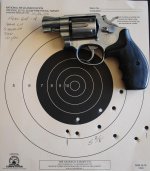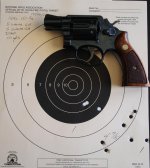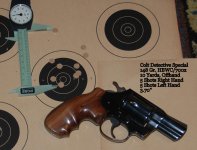I was going to grab a handful of snub's and go to the range this morning and just shoot left handed (weak side). That should make for a really frustrating morning of shooting :~)
You are using an out of date browser. It may not display this or other websites correctly.
You should upgrade or use an alternative browser.
You should upgrade or use an alternative browser.
INTERNET SNUBBY MATCH
- Thread starter David R
- Start date
BB57, from the first post to this thread, way back when;
A snubby is 2" or less for 10 yards.
A snubby is 3" or less for 25 yards.
I hadn't read through to see if that ever changed. Think I'll have to polish up that 3" model 60!
I've got a much less demanding work and travel schedule now that leaves me home all but 3 days of each pay period, so I'm fixin to get interested in these monthly matches.
I did read a few of the other matches and it's not real clear to what degree barrel length applies.
If you take a literal read on it, then a 2.125" snubby should be fired at 25 yards as is it over 2". For S&W and Ruger purposes that leaves primarily the 1 7/8" LCR and J-frame revolvers (and a smaller number of 2" K-frames) in the 2" / 10 yard class while the 2.125", 2.25", 2.75" and 3" revolvers all fall in the 25 yard class.
In a 25 yard two hand single action match, sight radius is indeed a significant factor. However the shorter the range, the less difference it will make in the overall outcome.
However as a practical matter, I don't think most of us would regard the extra 1/4" sight radius of the 2.125" revolver over a 1 7/8" revolver as having any real advantage even at 25 yards, so it might make sense to define the classes as 2.25" or less and 3" or less. If there is truly a sight radius or accuracy advantage to a 2.75" or 3" snubby over a 2.125" or 2.25" snubby in a match, then it leaves those very common barrel 2.125: and 2.25" barrel lengths at a disadvantage in the 3" class.
As is, it's unclear how 2.125" barrels are classified in some matches. There was for example a recent 3,5,7 and 15 yard match with no mention of barrel length and some 2.125" barrel entries along with the 1 7/8" entries. So it was either a case of counting 2.125" barrels as 2", or a case of barrel length (provided it was 3" or less) not mattering.
It's also maybe a little counter productive to draw the line at 2.0", as that's not the only dimension involved in sight radius. An adjustable sight Model 60 has 1 7/8" from the rear sight to the start of the barrel, while a K-framed sized revolver with adjustable sights will pick up an extra 1/8" of sight radius. That would allow a 2" barrel K frame in the 2" class while the 2.125" barrel J frame is excluded, even thought the sight radius of both revolvers is essentially identical. Plus the K-frame is much heavier, arguably easier to shoot, and somewhat less in keeping with the concept of a small snubby revolver.
However for many matches, like this one where it includes weak hand shooting, I don't think the extra 7/8" or even 1 1/8" of sight radius on a 3" over a 2.125" barrel or 1 7/8" barrel revolver offers any meaningful advantage at 10 yards, particularly as it's the weak hand, DA aspect of the match that is the limiting factor, not the sight radius. In a match like this I'm not sure separate barrel length classes are meaningful - thus the initial question.
I'm just asking for clarification as the issue seems to be a little fuzzy looking at past months, and specifying barrel length as well as any differences in shooting distances in the matches for each month would be helpful, given the variety in the matches. If we don't need to classes, that's a plus as it increases participation and competition in the single class.
And, in a match like this some folks may opt out of the 3" class entirely, given the challenge of hitting a target at 25 yard target at 25 yards in DA mode with the weak hand with any revolver between 2.0 and 3".
------
In any case, I'll plan on re-shooting the 2 3/4" and 3" revolvers at 25 yards - but I expect some people to step up and provide some competition in the 3" class.
I'll also shoot my 1 7/8" Model 36s at 10 yards as well as my 2.125" Model 60 at 10 yards, as I think the .125" extra barrel length is splitting hairs in this particular match.
Last edited:
I don't look at this match with any formality at all. I think it is a "shoot what ya brung" style match and barrel length really doesn't mean much, especially for weak hand double action shooting. I think of it just to have fun.
Ok, I didn't have as much time as I'd hope and the light was fading so I focused on 25 yards, practiced a bit, then shot this with my 3" Model 60 with a 5.87" group:

My 2 3/4" Ruger Speed Six's 6.0" group wasn't bad either. I may need to file just a bit off the right side of the front sight:

I shot the 3" SP101 as well but in the fading light I had to use a 6 o'clock hold to get a clear sight picture, and it put a couple rounds off the bottom of the target.

My 2 3/4" Ruger Speed Six's 6.0" group wasn't bad either. I may need to file just a bit off the right side of the front sight:

I shot the 3" SP101 as well but in the fading light I had to use a 6 o'clock hold to get a clear sight picture, and it put a couple rounds off the bottom of the target.
Reading some of David R's posts, he was pretty loose about things like exact barrel length. I like that approach, and if someone wants to shoot a 2 1/4 inch barrel where the rules say 2 inches, that's OK by me. After all, we aren't conducting a 'leg' match here. The imnportant thing is for as many people as possible to get out and shoot.
David R
Member
Thank you for carrying on. Life deals some bumps and curves in the road. Still out for another few weeks.
Yes, the idea is get out and shoot!
David
Yes, the idea is get out and shoot!
David
David R, wish I had found this match when you started it in May of 2014. Some of the best fun I've had on the range in some time. I really love feeling very, very stupid sometimes looking at the target when I'm done. :~) It is the first time in 55 years of pistol shooting I've used my other hand. Thanks.
OLDNAVYMCPO
US Veteran, Absent Comrade
Here is 20 @ 10 yd. into a 3 " square from my old Mod. 60 using 5 gr. Unique and 140 gr. Speer HP.

Good shooting!! What's the distance, center to center of the two outermost bullet holes.? That's how we count group size.
RobertJ.
Member
I didn't win, but I'm posting this anyway, because I was pleasantly surprised.
Our weather gave us a nice break from the rain, and while the sun was shining, I headed out to the range. It's 45 minutes from here, but a nice drive through the woods.
10 shots, offhand, 5 right hand only, 5 left hand only, into 3.70"
I shot this with a load for a different revolver. The three in the white were lefty, I lost track of which of the others were. I hadn't tried this particular load in the DS, and it turns out it shoots to the same POA as the +P JHP I carry.
Our weather gave us a nice break from the rain, and while the sun was shining, I headed out to the range. It's 45 minutes from here, but a nice drive through the woods.
10 shots, offhand, 5 right hand only, 5 left hand only, into 3.70"
I shot this with a load for a different revolver. The three in the white were lefty, I lost track of which of the others were. I hadn't tried this particular load in the DS, and it turns out it shoots to the same POA as the +P JHP I carry.
Attachments
WE HAVE A WINNER!!
And the winner is Stu1ritter with a group size if 2.75". Runner up is Robert J with a group of 3.7". Good shooting, guys! And thanks to all the participants. Yours truly shot a dismal 4.5", coming in third.
Stay tuned for the particulars of the December match, as soon as I figure out what it will be.
And the winner is Stu1ritter with a group size if 2.75". Runner up is Robert J with a group of 3.7". Good shooting, guys! And thanks to all the participants. Yours truly shot a dismal 4.5", coming in third.
Stay tuned for the particulars of the December match, as soon as I figure out what it will be.
David R
Member
I didn't win, but I'm posting this anyway, because I was pleasantly surprised.
Snip...
You won, You got out and shot.
David
David R
Member
December match:
10 rounds NOT Standing on your feet. Sitting in a chair, Laying on the floor, Creedmore position, Prone,...... You decide, just not standing on your feet.
Draw from concealment, fire 5, reload and fire 5 more 7 yards, the standard gunfight distance. One hand or two.
gunfight distance. One hand or two.
Thanks for keeping this going. I intend to shoot, probably prone, hopefully with my 624.
David
10 rounds NOT Standing on your feet. Sitting in a chair, Laying on the floor, Creedmore position, Prone,...... You decide, just not standing on your feet.
Draw from concealment, fire 5, reload and fire 5 more 7 yards, the standard
Thanks for keeping this going. I intend to shoot, probably prone, hopefully with my 624.
David
David R. Glad to see you're back. We mised you.
Quick question about the December match: Double action of single action?
I intend to shoot from a chair. With my creaky joints, if I could get into prone or supine (creedmore), it would take a crane to get me vertical again. I probably give up something in steadiness to people shooting from prone.
Quick question about the December match: Double action of single action?
I intend to shoot from a chair. With my creaky joints, if I could get into prone or supine (creedmore), it would take a crane to get me vertical again. I probably give up something in steadiness to people shooting from prone.
David R
Member
I did not stipulate so what ever you want, please tell which along with the target. I plan to use two hands double action. This is not a bench rest match.
David
David
My range doesn't allow any holster work so I'll grab it off the table.
My range doesn't allow any holster work so I'll grab it off the table.
I'll stick mine in my pocket.
Similar threads
- Replies
- 8
- Views
- 426
- Replies
- 2
- Views
- 659
- Replies
- 0
- Views
- 170
- Replies
- 38
- Views
- 2K



